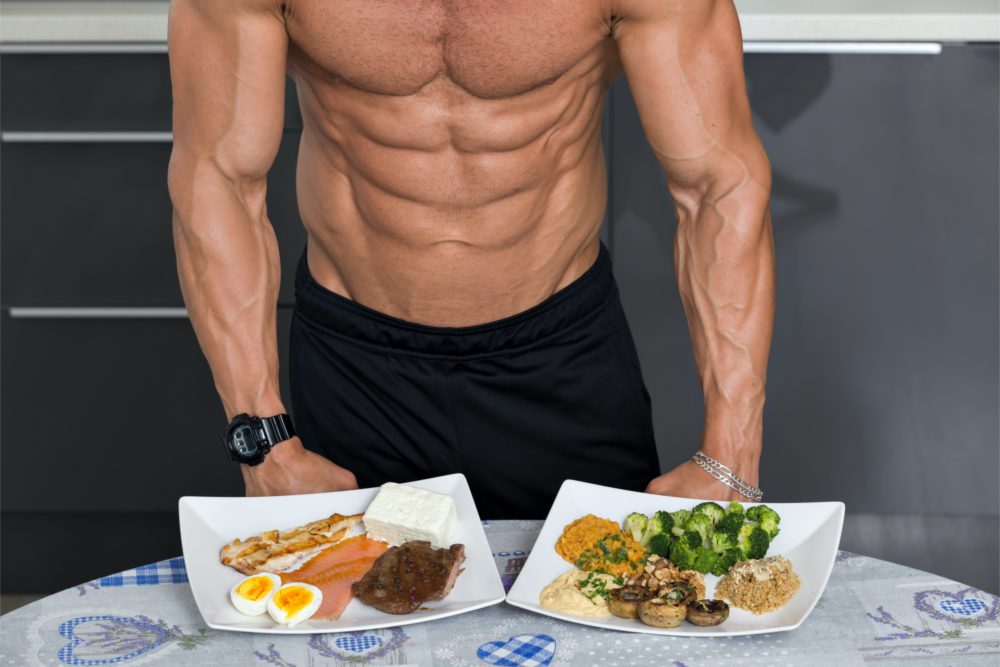You’re a card-carrying meathead. You’ve spent months and years clanging and banging in the gym, getting strong as all get out, and eating like an adult gorilla to lay down some new body armour.
You’ve been successful. You’re now jacked.
But, in that process, you’ve laid down a little bit (or a lot bit) of body fat (and that’s inevitable if you’re serious about massing) and now it’s time to cut. Time to reveal the fruits of your labor, get “peeled” and have a great unveiling.
This means you are going to have to reel it in in the kitchen and enter a calorie deficit to shed the fat. This seems simple enough to us meatheads: keep the protein high, reduce the carbs, cut down on the portions, watch the overall calories…and it’s all good.
In theory, yes, it should be. Easy enough. However, in reality, doing a long cut is a grind…both physically and psychologically. Yes, overall calories (tracking them accurately) and being in a consistent calorie deficit is king when cutting. Protein is second in the hierarchy of importance.
But-and this rarely gets talked about-learning how to optimize your food volume and remain somewhat satiated while on a reduced calorie diet is a very close third in my opinion. Yes, anything can “fit your macros”, and calories matter (a lot)…but they are not ALL that matter. Choosing foods which offer a high physical volume and a low/lower energy density is crucial if you want to cut successfully, sustainably and without being totally miserable and ravenous.
One of the best (not only) ways to achieve this-a secret weapon if you will-is to replace your traditional starchy carbohydrate sources (rice, potatoes, bread products, oats, etc.) with lower calorie (often significantly) plant-based alternatives which offer the same or higher food volume. Besides the calorie savings, the foods I’ll present in this article also have a high fiber and water content: they’ll trick your brain into thinking you are full and, in the case of fiber, have a fat burning effect.
Now, I know what you are thinking:
“Bro. Really? Plant-based foods? That’s so ‘froo froo’ and granola. I bet you take yoga and wear Lululemon too don’t you? I’m a meathead…I can’t eat that hippie stuff.”
Hey look…I get it. That said, part of the pursuit of a better and better physique over time is the willingness to adapt your thinking, change your mind, and be open to new things (particularly things which make good physiological sense and make your fat loss phase better and more tolerable). So just hear me out and read on.
Now, before I present my favorite plant-based fat loss foods for meatheads, I want to make it clear: I’m in no way saying “You should cut out all rice, potatoes, fruit, bread and oats”. Not in the least bit. You can and still should consume some of those on the regular. What I AM saying is maybe opt for the foods I’m going to discuss a little more often (you may find you start turning to them more often than not). It’s just a strategy-a rabbit to pull out of the hat-but one I found to be INSANELY effective during my most recent cut.
So, without further ado, here are my 4 favorite plant-based traditional carb alternatives:
1 – Shirataki Noodles/Rice
These are made from glucomannan, a type of fiber that comes from the root of the Japanese konjac plant. Glucomannan is a highly viscous fiber containing very few digestible carbs (glucomannan is heralded as an appetite suppressant). Shirataki contains virtually no calories and moves through your digestive tract slowly, delaying stomach emptying, helping you feel fuller longer. A 200g serving of Shirataki noodles or rice contains a mere 30 calories, only 8g of carbs, and 6g of fiber (compare to the same serving size of pasta…you’ll be blown away with the calorie difference).
The best way to prepare Shirataki in order to remove the salt and fish-like smell is to rinse it in a coriander and then use a paper towel to soak up the excess water. Heat up a skillet on medium high heat and cook for a few minutes. You can top with any lean protein source and some type of low/no cal condiment, dipping sauce, marinade, etc. You can also add fibrous veggies during the cooking process to add more bulk, volume and fiber for minimal calories.
My favorite brands of Shirataki can be found below:
2 – Hearts of Palm Noodles/Rice
These are made from hearts of palm-a white vegetable obtained from the center of specific varieties of palm tree. While usually added to salads in larger chunks, several companies are now offering it canned or in pouches in rice or pasta-like textures and shapes.
Like Shirataki, it is ultra low in calories, low in carbs, has trace dietary fat and has a high fiber and water content, helping to promote feelings of fullness. What’s more, it’s a micronutrient powerhouse containing excellent levels of potassium, copper, zinc and phosphorus.
A 200g serving of hearts of palm contains 72 calories, 8g of protein, 1g of fat, 8g of carbs and 8g of fiber. It, in my opinion, has a more rice or pasta-like texture than Shirataki and I prefer it over Shirataki. Like Shirataki, it’s best to rinse in a coriander, pat dry, and then cook up in a skillet. Top with a lean protein source and low-calorie sauce or marinade of your choice. Also works great in a stir fry with fibrous veggies.
My favorite brand of hearts of palm can be found below:
3 – Riced Cauliflower & Riced Broccoli
As the name implies, these are just riced versions of two common cruciferous vegetables. Like the others above, riced broccoli/cauliflower offers high volume, low calories, high fiber and is packed with micronutrients. It’s a perfect ultra low-calorie, low-carb alternative to traditional rice varieties.
A 200g serving of riced broccoli/cauliflower offers only 35 calories, 0g fat, and 6g of carb and fiber. You can’t go wrong with this!
While most varieties are sold in microwavable pouches, I prefer to cook mine in a skillet with seasoning of choice and almost char it. Top with a lean protein, a low-calorie sauce/marinade, and/or additional fibrous vegetables to add more bulk and keep you fuller on fewer calories.
My favorite brand of riced broccoli/cauliflower can be found below:
4 – Spaghetti Squash
Last but not least is spaghetti squash, a vibrant winter vegetable enjoyed for its nutty flavor and impressive nutrient profile. To turn this into a pasta-like consistency, slice in half lengthwise, poke holes in the skin with a fork, and bake in a baking dish at 400 degrees for about 45 minutes. Once cooked, use a fork to flake out the insides…the result is a pasta-like consistency.
A 300g (high volume) serving provides a mere 80 calories, 20g of carbs, and 4g of fiber. It’s also an excellent source of vitamin C, manganese, and vitamin B6.
Just like the 3 other plant-based carb alternatives, the high water and fiber content is going to keep you fuller…longer…for fewer calories. Again, top with a lean protein source and low-calorie sauce/marinade of your choice and you have a perfect satiating fat loss meal.
Spaghetti squash can be found in the produce department of any grocer.

P. J. Striet is a 25 year fitness industry veteran and is the owner of Revive Fitness Systems LLC, an online coaching company specializing in fat loss nutrition and innovative training for “real world” adults. You can find out more about him using the links below.

Thanks for the info! I especially appreciate which brands to try.
I’m really glad you liked it, Karla. Happy holidays!
Glad you enjoyed it Karla!